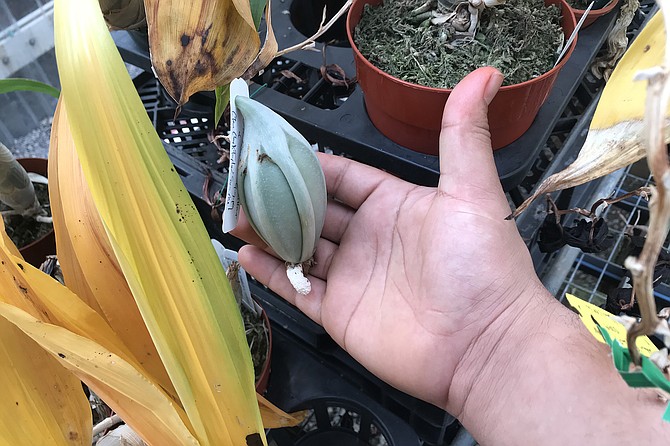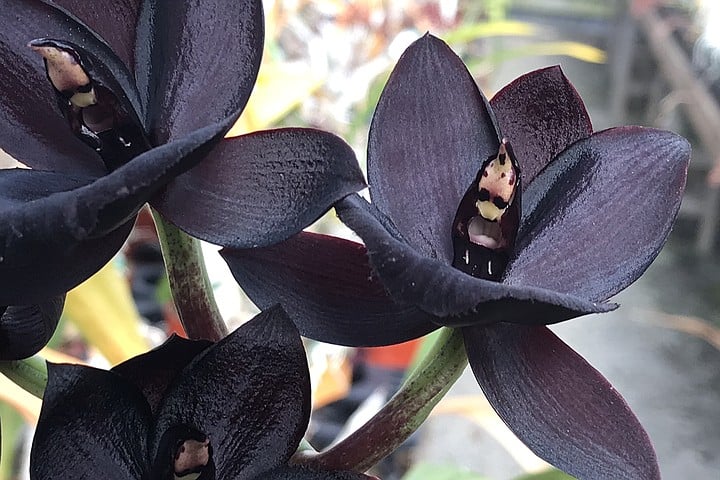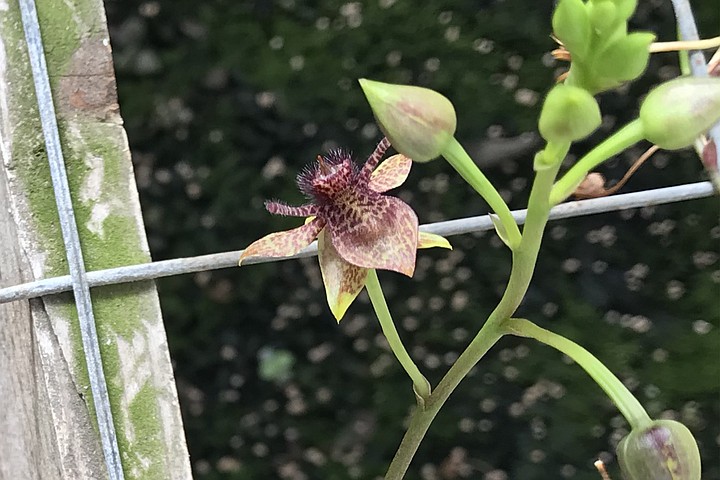 Facebook
Facebook
 X
X
 Instagram
Instagram
 TikTok
TikTok
 Youtube
Youtube

What is it about orchids that turns sane people into obsessed collectors and fanatics? Especially the legendary black orchid?
If you look, black orchids are everywhere and nowhere. Movies such as Black Orchids — a 1917 silent film; the classic comic-strip, Brenda Starr, Reporter, whose main squeeze depended on a concoction of black orchids to survive; iconic explorer Colonel Percy Fawcett who disappeared in the Amazon rainforest in 1925, looking for, legend says, the elusive black orchid.
Except no-one had ever seen one, until Fred Clarke turned up. This orchid breeder has created the world’s first actual black orchid.

Up here in the hills surrounding Vista, in a humid hothouse, Clarke’s colleague Carlos Lopez leads me through rainbow racks of orchids. The black orchid was a holy grail for orchid hybridizers, he says. He leans over and from behind some other multi-colored orchids, pulls out a black orchid plant! The flowers are deep purple black, each with a bird-shaped sexual organ column sticking up in the middle, and a velvety sensuality about them.
Fred Clarke says he managed, through years of cross-pollination, hand-“impregnating” different colored flowers’ reproductive organs with other orchids’ tiny micro-seeds, to create the first-ever really black, black orchids.
Clarke’s breakthrough happened 13 years ago. But that was after waiting five, six years for his hybrids to slowly grow up, to see if they would actually produce when they came to maturity.
They did.
“Fred was the first person on the planet to lay eyes on a black orchid,” says Lopez. “He has called it the ‘FredClarkeara After Dark.’”

Normally, orchids don’t need help reproducing. They play sex games like the rest of us. They grow leaf extensions that actually look like bees. “Every orchid species has about one or two precise pollinators to attract the correct insects,” he says.
To get pollinated, orchids play insects for fools. “Sometimes, their fragrance mimics pheromones given off by certain female insects, to trick males into thinking the orchid is a female insect. The male insect goes investigating into the flower. They slip in, trip a kind of lid, and when they become trapped and are trying to escape, they have to climb up right by where the pollen is. It sticks to their back, they escape and fly away to unknowingly pollinate another orchid.”

And Lopez says many orchids produce a thank-you in the form of a sweet sap-like substance, a reward that keeps the insects coming back. And the insects, like the specialist Euglossine bees, will pick up the phenols from miles around. Their jobs are different, depending on if the orchid is in its male or female phase. Lopez sniffs his black orchid. “This has banana-like smells,” he says. “Others smell more like Lemon Pledge.”
And, curiously, says Lopez, orchids also visually resemble all sorts of human sex organs. “Is it a coincidence the [sepals and petals] are shaped like a vagina? That the ‘lip’ resembles a clitoris? Or that the very name ‘orchid’ means ‘testicle’ in Greek?”
Clarke’s black orchid success has meant healthy sales in plants and clones. And fame. Like, right now, he’s lecturing and judging orchids in Costa Rica, says Lopez.
“He was already famous. But ever since he created the black orchid, Fred’s hot.”


What is it about orchids that turns sane people into obsessed collectors and fanatics? Especially the legendary black orchid?
If you look, black orchids are everywhere and nowhere. Movies such as Black Orchids — a 1917 silent film; the classic comic-strip, Brenda Starr, Reporter, whose main squeeze depended on a concoction of black orchids to survive; iconic explorer Colonel Percy Fawcett who disappeared in the Amazon rainforest in 1925, looking for, legend says, the elusive black orchid.
Except no-one had ever seen one, until Fred Clarke turned up. This orchid breeder has created the world’s first actual black orchid.

Up here in the hills surrounding Vista, in a humid hothouse, Clarke’s colleague Carlos Lopez leads me through rainbow racks of orchids. The black orchid was a holy grail for orchid hybridizers, he says. He leans over and from behind some other multi-colored orchids, pulls out a black orchid plant! The flowers are deep purple black, each with a bird-shaped sexual organ column sticking up in the middle, and a velvety sensuality about them.
Fred Clarke says he managed, through years of cross-pollination, hand-“impregnating” different colored flowers’ reproductive organs with other orchids’ tiny micro-seeds, to create the first-ever really black, black orchids.
Clarke’s breakthrough happened 13 years ago. But that was after waiting five, six years for his hybrids to slowly grow up, to see if they would actually produce when they came to maturity.
They did.
“Fred was the first person on the planet to lay eyes on a black orchid,” says Lopez. “He has called it the ‘FredClarkeara After Dark.’”

Normally, orchids don’t need help reproducing. They play sex games like the rest of us. They grow leaf extensions that actually look like bees. “Every orchid species has about one or two precise pollinators to attract the correct insects,” he says.
To get pollinated, orchids play insects for fools. “Sometimes, their fragrance mimics pheromones given off by certain female insects, to trick males into thinking the orchid is a female insect. The male insect goes investigating into the flower. They slip in, trip a kind of lid, and when they become trapped and are trying to escape, they have to climb up right by where the pollen is. It sticks to their back, they escape and fly away to unknowingly pollinate another orchid.”

And Lopez says many orchids produce a thank-you in the form of a sweet sap-like substance, a reward that keeps the insects coming back. And the insects, like the specialist Euglossine bees, will pick up the phenols from miles around. Their jobs are different, depending on if the orchid is in its male or female phase. Lopez sniffs his black orchid. “This has banana-like smells,” he says. “Others smell more like Lemon Pledge.”
And, curiously, says Lopez, orchids also visually resemble all sorts of human sex organs. “Is it a coincidence the [sepals and petals] are shaped like a vagina? That the ‘lip’ resembles a clitoris? Or that the very name ‘orchid’ means ‘testicle’ in Greek?”
Clarke’s black orchid success has meant healthy sales in plants and clones. And fame. Like, right now, he’s lecturing and judging orchids in Costa Rica, says Lopez.
“He was already famous. But ever since he created the black orchid, Fred’s hot.”
Comments